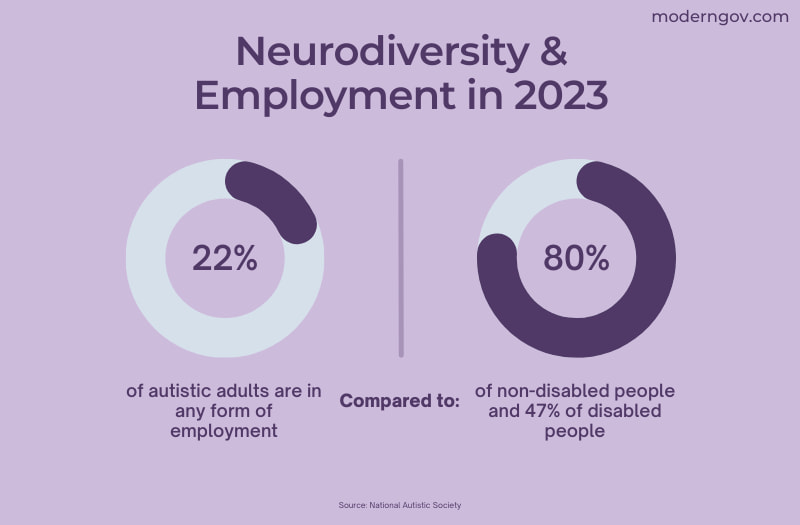The Value of Neurodiversity in the Workplace and How to Support Neurodiverse Individuals
 Alice Mallalieu
·
4 minute read
Alice Mallalieu
·
4 minute read
Neurodiversity is often an overlooked aspect of diversity and inclusion but can bring huge strength to an organisation.
Everyone learns, thinks, works, and processes information in different ways.
By embracing and utilising these differences your organisation and employees can see huge benefits
It is estimated that around 1 in 7 people (more than 15% of people in the UK) are neurodivergent. However, unemployment for neurodivergent adults runs at least as high as 30-40% which is three times the rate for people with disability, and eight times the rate for people without disabilities.
This blog post will outline some key areas to help your organisation better support neurodiverse employees.
Understanding Neurodiverse Conditions
Neurodiversity refers to the differences in brain functions and the different characteristics and behavioural traits this can bring.
Neurodiversity covers a wide range of conditions, including ADHD, Autism, Dyspraxia, Dyslexia, Dyscalculia, Dysgraphia, and Tourette's syndrome. It would be remiss not to acknowledge the variation of characteristics these conditions can present. No one neurodiverse individual will present the same traits and therefore the potential characteristics can differ from person to person.
Reframing these differences as an important and valuable element of diversity helps us to embrace them as strengths.
Advantages of Neurodiversity in the Workplace:
-
Attention to detail
-
Creativity
-
Visual thinking
-
Retention of information
-
Problem-solving
-
Analytical thinking
Most organisations will employ neurodiverse individuals whether they are aware of it or not. Research carried out by O2 found that 81% of those with a condition such as autism, ADHD, or dyslexia, felt that there is an opportunity for them to be better supported at work.
There is more to be done to ensure the integration and inclusion of neurodiverse individuals in the workplace. Exploring recruitment and retention strategies, reasonable adjustments and communication styles can open the door to support and unlock the full potential of neurodiverse professionals.
How to Support Neurodiverse Individuals During the Recruitment Process
Interviews, Assessments and Work Trials
Ensuring neurodiversity is integrated into your organisation's policies starts with the recruitment process.
The first step in gaining the value and skills that neurodiverse individuals can bring to your organisation is to attract those with neurodiversity through open and conscious advertising, screening, and interviewing processes.
Job Specifications
Job specifications provide the basis of any job hunt, outlining the requirements, skills and experience required for the role. Ensuring specifications include only requirements for the job, not irrelevant personal characteristics opens up the search to those who would thrive in the role but may feel alienated by the pressure to fulfil social characteristics.
The Screening Process
Evaluating your organisation's screening process and removing unconscious bias is important in order to assess the true job capabilities of candidates more accurately than dismissing those that may deviate from the expected social cues such as eye contact or atypical expressions.
Interviews
Too often we see neurodiverse individuals struggle at the interview stage, due to stringent personality-based interview techniques that overshadow the individuals’ talents and technical skills that relate to the specific role.
Ensuring your organisation's recruitment process provides opportunities to display expertise and technical talent, rather than a reliance on solely a formal question-and-answer style interview can allow those often excluded or dismissed to demonstrate their capabilities.
Practical Exams, Tests and Trials
Practical exams and tests can provide greater insight into your candidate’s ability to understand and demonstrate the type of work that would be undertaken in the advertised role. However, we should again acknowledge the potential difficulties this can present in neurodiverse individuals.
There are reasonable adjustments that can ease these difficulties, providing extra time for assignments, allowing the candidate to use their own technology rather than unfamiliar company devices and discussing ways to ensure the work environment is suitable for the candidate.
Perhaps the best way to assess your candidate’s ability to thrive in the vacant role is to consider a work trial period. This allows the candidate to settle into the work environment, surrounded by and supported by colleagues.
Creating a Neurodiverse Work Environment: Advice for Employers
Many of the elements outlined to support the recruitment process are transferable and important accommodations for employees throughout their work life.
The presence of these accommodations alone can provide reassurance and a welcoming environment for those that may feel less able to initiate the conversation. The role of the employer is to safeguard employees and create a space for all to thrive, making reasonable accommodations where appropriate.
How to Develop a Neurodiverse Work Environment:
- Ensure neurodivergent employees are included in discussions and are central in the decision-making processes that affect them and are about them.
- Create an environment that can provide both flexibility and inflexibility, depending on the employee’s needs. While some thrive with clearly set objectives and deadlines others may need more flexibility with deadlines and work commitments.
- Consider neurodiverse employees in your working arrangements – whether that be tailoring a hybrid work schedule to meet the needs of the employee, ensuring a dedicated quiet workspace away from external noises and pressures or providing assistive technology to aid work.
- Education is key: remove stereotypes around neurodiversity and create a culture of inclusion through continuous learning and awareness of neurodiverse conditions and how to better support them.
Of course, this is by no means a comprehensive list of all that should be done to create a neurodiverse-inclusive work environment. But does highlight some of the areas that should be considered.
How to Manage Neurodiverse Individuals
While the presence of accommodations can provide great reassurance to neurodiverse individuals entering or already in the workplace. It is important to consider how we interact and manage neurodiversity to ensure optimal outcomes for all.
Often those with neurodiverse conditions will communicate differently than neurotypical individuals. It is important to acknowledge these differences and provide the necessary support. Here are some aspects to consider to ensure effective communication:
-
Where appropriate, using closed rather than open questions
-
Make use of digital resources to support communication: speech-to-text software may be helpful
-
Try to avoid using jokes, sarcasm or ambiguous statements, instead use clear and direct statements
Ultimately the most important aspect of communication is keeping your employees at the heart of your considerations. Constant and welcoming discussions from the recruitment process, onboarding and onwards, with those with neurodiverse conditions is essential to providing the support and resources needed and central to creating neurodiverse-friendly policies.
Provide Support Through Neurodiversity in the Workplace Training
To gain a more in-depth understanding of Neurodiverse conditions and how to better support them in the workplace, attend our Neurodiversity in the Workplace course.








